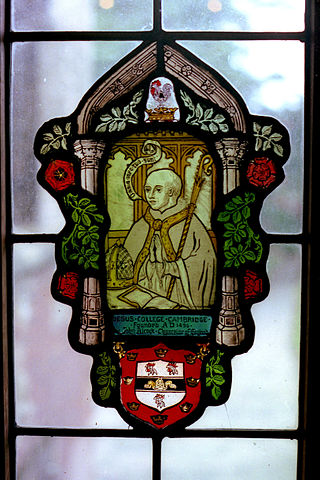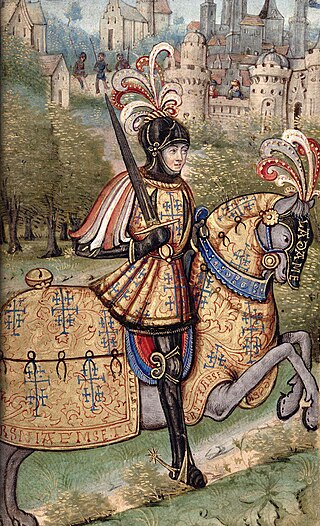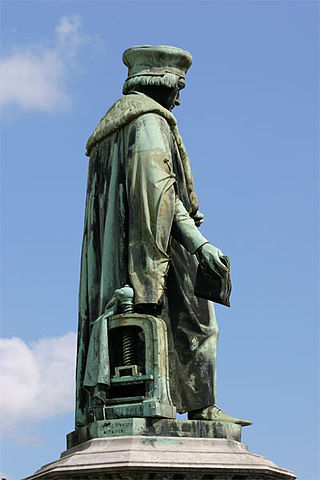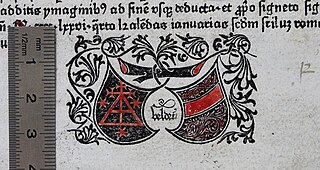Year 1473 (MCDLXXIII) was a common year starting on Friday of the Julian calendar.

Aalst is a city and municipality on the Dender River, 31 kilometres (19 mi) northwest from Brussels in the Flemish province of East Flanders. The municipality comprises the city of Aalst itself and the villages of Baardegem, Erembodegem, Gijzegem, Herdersem, Hofstade, Meldert, Moorsel and Nieuwerkerken; it is the tenth largest city by population with 90.068 inhabitants. Aalst is crossed by the Molenbeek-Ter Erpenbeek in Aalst and Hofstade. The current mayor of Aalst is Christoph D'Haese, from the New-Flemish Alliance party. The town has a long-standing (folkloric) feud with Dendermonde, which dates from the Middle Ages.
This article is a list of the literary events and publications in the 15th century.

John Alcock was an English churchman, bishop and Lord Chancellor.

Edward of Middleham, Prince of Wales, was the son and heir apparent of King Richard III of England by his wife Anne Neville. He was Richard's only legitimate child and died aged seven or ten.

René II was Count of Vaudémont from 1470, Duke of Lorraine from 1473, and Duke of Bar from 1483 to 1508. He claimed the crown of the Kingdom of Naples and the County of Provence as the Duke of Calabria 1480–1493 and as King of Naples and Jerusalem 1493–1508. He succeeded his uncle John of Vaudémont as Count of Harcourt in 1473, exchanging it for the county of Aumale in 1495. He succeeded as Count of Guise in 1504.

Recuyell of the Historyes of Troye or Recueil des Histoires de Troye (1464) is a translation by William Caxton of a French courtly romance written by Raoul Lefèvre, chaplain to Philip III, Duke of Burgundy. It was the first book printed in the English language.
Sir Christopher Willoughby, de jure10th Baron Willoughby de Eresby, KB, was heir to his second cousin, Joan Welles, 9th Baroness Willoughby de Eresby, in her own right Lady Willoughby, as well as great-grandson and heir male to William Willoughby, 5th Baron Willoughby de Eresby. Christopher Willoughby was also heir to his elder brother, Robert Willoughby, who died unmarried and underage on 24 March 1467. He was unable to enjoy his inherited title as a result of the attainders of his cousin Joan Welles' father, Richard Welles, 7th Baron Welles, and brother, Robert Welles, 8th Baron Willoughby de Eresby.

The global spread of the printing press began with the invention of the printing press with movable type by Johannes Gutenberg in Mainz, Germany c. 1439. Western printing technology was adopted in all world regions by the end of the 19th century, displacing the manuscript and block printing.

Dirk Martens was a printer and editor in the County of Flanders. He published over fifty books by Erasmus and the very first edition of Thomas More's Utopia. He was the first to print Greek and Hebrew characters in the Netherlands. In 1856 a statue of Martens was erected on the main square of the town of his birth, Aalst.
Events from the 1470s in England.

Guido de Monte Rochen or Guy de Montrocher was a French priest and jurist who was active around 1331. He is best known as the author of Manipulus curatorum, a handbook for parish priests, that was often copied, with some 180 complete or partial manuscripts surviving, and later reprinted throughout Europe in the next 200 years, with at least 119 printings, and sales which have been estimated to be three times those of Thomas Aquinas' Summa Theologica. It became obsolete only when the Council of Trent created the Roman Catechism in 1566.

Hermann IV of Hesse was the Archbishop-Elector of Cologne from 1480 to 1508 and the Prince-Bishop of Paderborn from 1498 to 1508.

Jean Bilhères de Lagraulas or Jean Villier de la Grolaie, or Groslaye etc., also called the Cardinal of Saint-Denis, was a French Roman Catholic abbot, bishop and from 1493 cardinal. He died as French ambassador in Rome, and is remembered for commissioning Michelangelo in 1498 to sculpt his Pietà for St. Peter's Basilica.

Johann Veldener, also known as Jan Veldener or Johan Veldenaer; was an early printer in Flanders. He worked as a punchcutter and printer in Cologne, together with William Caxton, who may have financed his first books. They both left for Flanders in 1472. Evidence indicates that Veldener assisted Caxton in setting up his printing office in Bruges and helped printing his first work there, the 1472-1473 Recuyell of the Historyes of Troye by Raoul Lefèvre. Afterwards, Veldener went to Leuven and set up his printing company there, becoming the second printer in Leuven after John of Westphalia, and the third or fourth in the Netherlands. He entered the Leuven University on 30 July 1473 in the faculty of Medicine.
John Lettou or John of Lithuania was an English bookbinder and printer, presumably Lithuanian from the Grand Duchy of Lithuania.

De honesta voluptate et valetudine was the first cookbook ever printed. Written c. 1465 by Bartolomeo Platina, it first appeared between 1470 and 1475 in Rome, and in 1475 in Venice. Written in Latin, it was largely a translation of recipes by Martino da Como from his Libro de Arte Coquinaria. The book was frequently reprinted over the next century, and translated into French, German and Italian.










